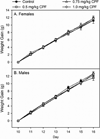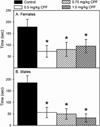Decreased anxiety in juvenile rats following exposure to low levels of chlorpyrifos during development
- PMID: 26642910
- PMCID: PMC5580823
- DOI: 10.1016/j.neuro.2015.11.016
Decreased anxiety in juvenile rats following exposure to low levels of chlorpyrifos during development
Abstract
Exposure to chlorpyrifos (CPF) during the late preweanling period in rats inhibits the endocannabinoid metabolizing enzymes fatty acid hydrolase (FAAH) and monoacylglycerol lipase (MAGL), resulting in accumulation of their respective substrates anandamide (AEA) and 2-arachidonylglycerol (2-AG). This occurs at 1.0mg/kg, but at a lower dosage (0.5mg/kg) only FAAH and AEA are affected with no measurable inhibition of either cholinesterase (ChE) or MAGL. The endocannabinoid system plays a vital role in nervous system development and may be an important developmental target for CPF. The endocannabinoid system plays an important role in the regulation of anxiety and, at higher dosages, developmental exposure to CPF alters anxiety-like behavior. However, it is not clear whether exposure to low dosages of CPF that do not inhibit ChE will cause any persistent effects on anxiety-like behavior. To determine if this occurs, 10-day old rat pups were exposed daily for 7 days to either corn oil or 0.5, 0.75, or 1.0mg/kg CPF by oral gavage. At 12h following the last CPF administration, 1.0mg/kg resulted in significant inhibition of FAAH, MAGL, and ChE, whereas 0.5 and 0.75mg/kg resulted in significant inhibition of only FAAH. AEA levels were significantly elevated in all three treatment groups as were palmitoylethanolamide and oleoylethanolamide, which are also substrates for FAAH. 2-AG levels were significantly elevated by 0.75 and 1.0mg/kg but not 0.5mg/kg. On day 25, the latency to emerge from a dark container into a highly illuminated novel open field was measured as an indicator of anxiety. All three CPF treatment groups spent significantly less time in the dark container prior to emerging as compared to the control group, suggesting a decreased level of anxiety. This demonstrates that repeated preweanling exposure to dosages of CPF that do not inhibit brain ChE can induce a decline in the level of anxiety that is detectable during the early postweanling period.
Keywords: Anxiety; Chlorpyrifos; Developmental; Endocannabinoid; Organophosphate insecticides.
Copyright © 2015 Elsevier B.V. All rights reserved.
Figures






Similar articles
-
Chlorpyrifos and Δ9 Tetrahydrocannabinol exposure and effects on parameters associated with the endocannabinoid system and risk factors for obesity.Curr Res Toxicol. 2021 Aug 8;2:296-308. doi: 10.1016/j.crtox.2021.08.002. eCollection 2021. Curr Res Toxicol. 2021. PMID: 34467221 Free PMC article. Review.
-
Low level chlorpyrifos exposure increases anandamide accumulation in juvenile rat brain in the absence of brain cholinesterase inhibition.Neurotoxicology. 2014 Jul;43:82-89. doi: 10.1016/j.neuro.2013.12.009. Epub 2013 Dec 25. Neurotoxicology. 2014. PMID: 24373905 Free PMC article.
-
Inhibition of Endocannabinoid-Metabolizing Enzymes in Peripheral Tissues Following Developmental Chlorpyrifos Exposure in Rats.Int J Toxicol. 2017 Sep/Oct;36(5):395-402. doi: 10.1177/1091581817725272. Epub 2017 Aug 18. Int J Toxicol. 2017. PMID: 28820005 Free PMC article.
-
Induction of endocannabinoid levels in juvenile rat brain following developmental chlorpyrifos exposure.Toxicol Sci. 2013 Sep;135(1):193-201. doi: 10.1093/toxsci/kft126. Epub 2013 Jun 12. Toxicol Sci. 2013. PMID: 23761300 Free PMC article.
-
Erythrocyte osmotic fragility and lipid peroxidation following chronic co-exposure of rats to chlorpyrifos and deltamethrin, and the beneficial effect of alpha-lipoic acid.Toxicol Rep. 2014 Jul 12;1:373-378. doi: 10.1016/j.toxrep.2014.07.002. eCollection 2014. Toxicol Rep. 2014. PMID: 28962253 Free PMC article. Review.
Cited by
-
Inhibition of fatty acid amide hydrolase by chlorpyrifos in juvenile rats results in altered exploratory and social behavior as adolescents.Neurotoxicology. 2020 Mar;77:127-136. doi: 10.1016/j.neuro.2020.01.002. Epub 2020 Jan 10. Neurotoxicology. 2020. PMID: 31931040 Free PMC article.
-
Persistent proteomic changes in glutamatergic and GABAergic signaling in the amygdala of adolescent rats exposed to chlorpyrifos as juveniles.Neurotoxicology. 2021 Jul;85:234-244. doi: 10.1016/j.neuro.2021.05.012. Epub 2021 May 28. Neurotoxicology. 2021. PMID: 34058248 Free PMC article.
-
Inhibition of Serum Esterases in Juvenile Rats Repeatedly Exposed to Low Levels of Chlorpyrifos.Int J Sci Res Environ Sci Toxicol. 2022;5(1):10.15226/2572-3162/5/1/00133. doi: 10.15226/2572-3162/5/1/00133. Epub 2022 May 13. Int J Sci Res Environ Sci Toxicol. 2022. PMID: 36118291 Free PMC article.
-
Chlorpyrifos and Δ9 Tetrahydrocannabinol exposure and effects on parameters associated with the endocannabinoid system and risk factors for obesity.Curr Res Toxicol. 2021 Aug 8;2:296-308. doi: 10.1016/j.crtox.2021.08.002. eCollection 2021. Curr Res Toxicol. 2021. PMID: 34467221 Free PMC article. Review.
-
Cnr1-/- has minimal impact on chlorpyrifos-mediated effects in the mouse endocannabinoid system, but it does alter lipopolysaccharide-induced cytokine levels in splenocytes.Chem Biol Interact. 2023 Apr 25;375:110425. doi: 10.1016/j.cbi.2023.110425. Epub 2023 Feb 27. Chem Biol Interact. 2023. PMID: 36858108 Free PMC article.
References
MeSH terms
Substances
Grants and funding
LinkOut - more resources
Full Text Sources
Other Literature Sources
Medical

